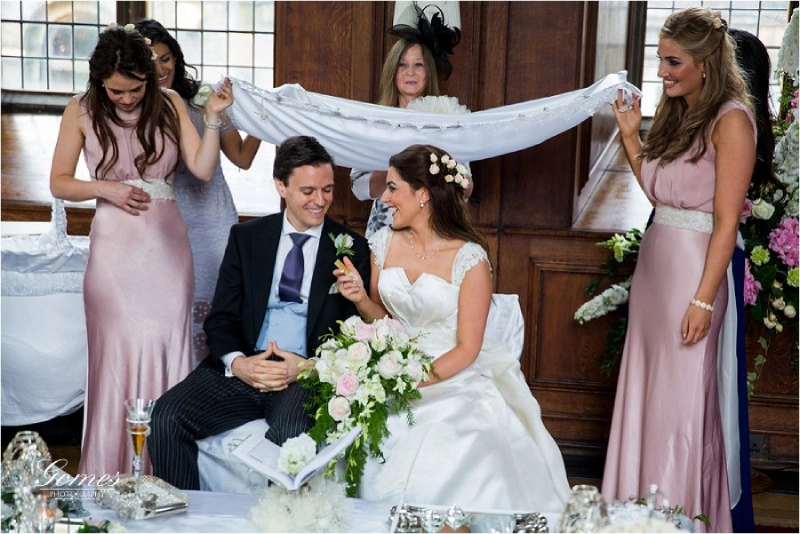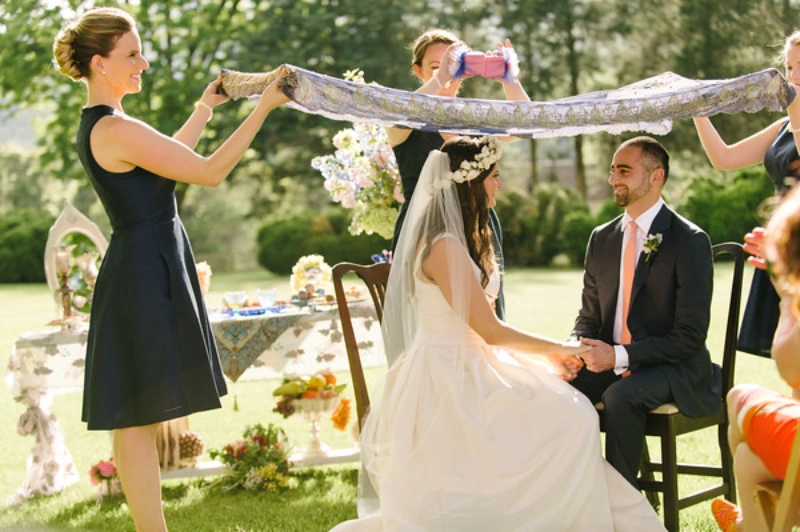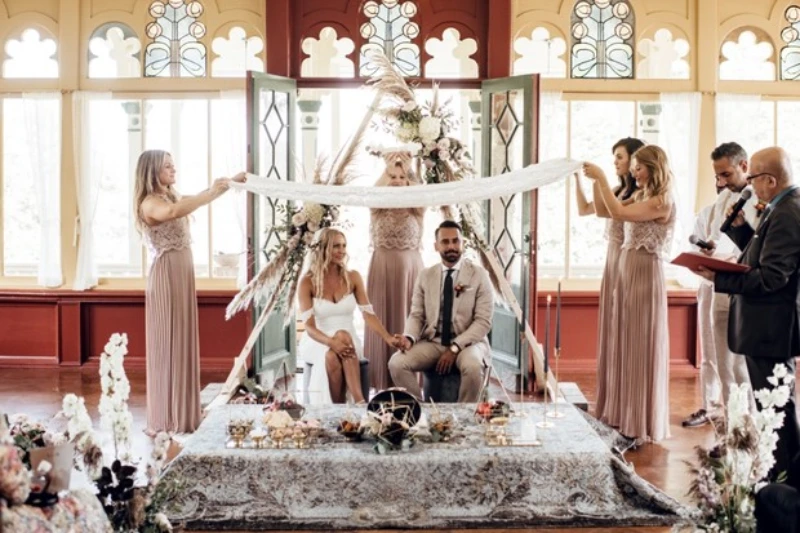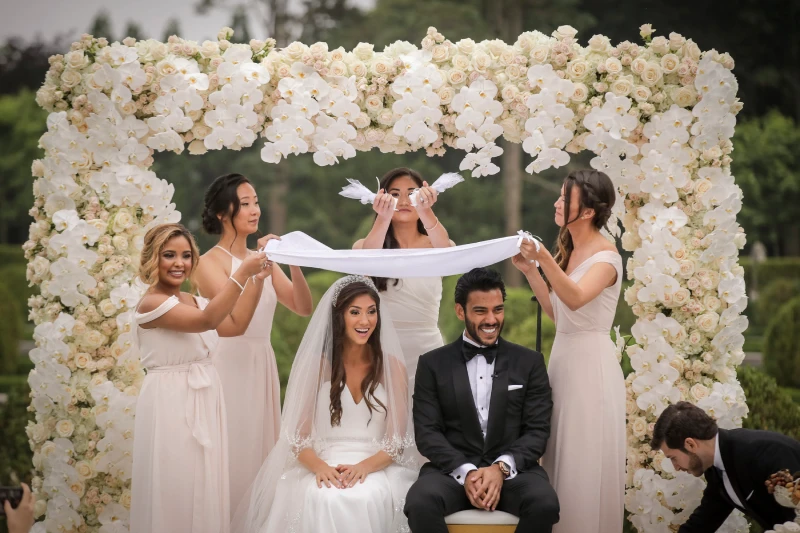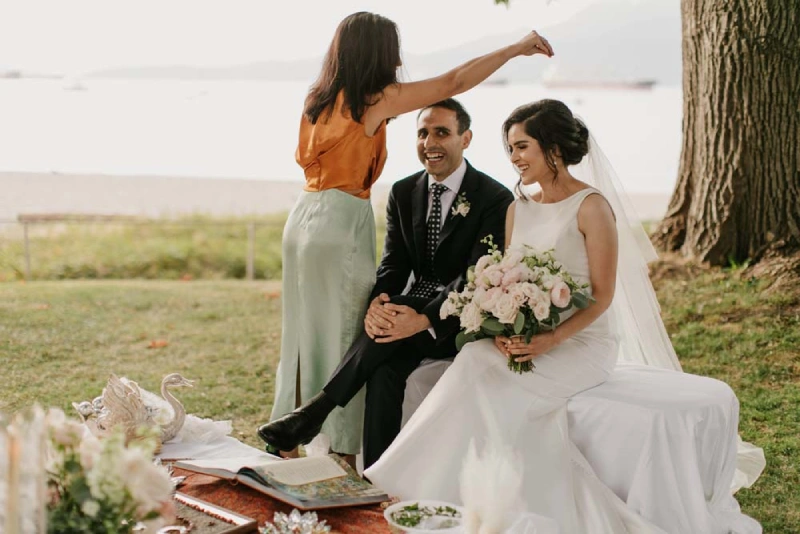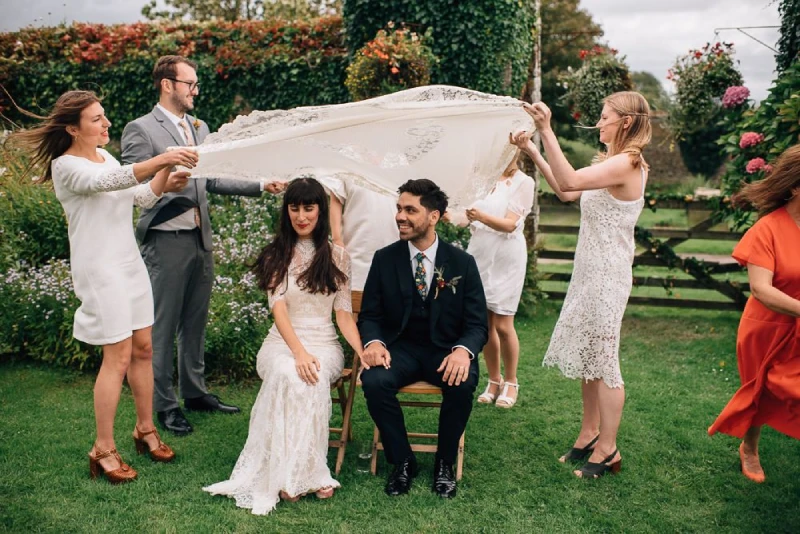Persian weddings, rich in tradition and vibrant in celebration, tell a story that stretches back thousands of years. At the heart of these ceremonies, Zoroastrian influences subtly shape customs and practices, weaving a tapestry of spirituality and cultural heritage. As couples embark on their journey of love, echoes of Zoroastrian beliefs can be seen in various aspects of modern Persian wedding rituals, from the sacred fire that symbolizes purity to the ritualistic blessings that honor the couple’s union. Each element serves as a reminder of the deep historical roots that continue to affect contemporary practices. This exploration of Zoroastrian influences reveals not just the beauty of Persian weddings but also highlights how ancient beliefs persist in nurturing love and unity today. Join us as we delve into the enchanting blend of tradition and modernity that defines modern Persian weddings, showcasing the timeless impact of Zoroastrianism.
Zoroastrian Influences in Modern Persian Wedding Rituals
Persian weddings, rich in tradition and vibrant in celebration, tell a story that stretches back thousands of years. At the heart of these ceremonies, Zoroastrian influences subtly shape customs and practices, weaving a tapestry of spirituality and cultural heritage. As couples embark on their journey of love, echoes of Zoroastrian beliefs can be seen in various aspects of modern Persian wedding rituals, from the sacred fire that symbolizes purity to the ritualistic blessings that honor the couple’s union. Each element serves as a reminder of the deep historical roots that continue to affect contemporary practices. This exploration of Zoroastrian influences reveals not just the beauty of Persian weddings but also highlights how ancient beliefs persist in nurturing love and unity today. Join us as we delve into the enchanting blend of tradition and modernity that defines modern Persian weddings, showcasing the timeless impact of Zoroastrianism.
Historical Context of Zoroastrianism in Persia
Zoroastrianism, one of the world’s oldest continuously practiced religions, originated in ancient Persia around the early part of the first millennium BCE. Founded by the prophet Zoroaster (or Zarathustra), it became the dominant religion of Persia before the advent of Islam. The teachings of Zoroaster emphasized a dualistic cosmology of good and evil, with a strong focus on the moral responsibility of individuals to choose good over evil. This religion profoundly influenced Persian culture, politics, and social norms for centuries, embedding its principles deeply into the daily lives of its adherents.
The rise of the Achaemenid Empire (550-330 BCE) saw Zoroastrianism flourish as the state religion, promoting values such as truth, righteousness, and the sanctity of nature. The rituals and ceremonies of Zoroastrianism were intricately woven into the fabric of Persian life, including the rites of passage such as weddings. Even as the Persian Empire evolved through various dynasties, including the Parthians and the Sassanids, Zoroastrianism remained a cornerstone of Persian identity, influencing everything from governance to personal conduct.
With the Arab conquest in the 7th century, Islam gradually supplanted Zoroastrianism as the dominant faith in Persia. However, Zoroastrianism’s influence did not vanish; instead, it became interwoven with Islamic and other cultural practices. This syncretism is particularly evident in Persian weddings, where Zoroastrian elements continue to play a significant role. The resilience of these traditions highlights the enduring legacy of Zoroastrianism in shaping Persian cultural and spiritual life.
Key Zoroastrian Beliefs and Their Relevance to Weddings
Zoroastrianism is built upon several core beliefs, many of which resonate deeply within the context of wedding rituals. Central to Zoroastrianism is the concept of dualism, the eternal battle between Ahura Mazda (the supreme god representing good) and Angra Mainyu (the destructive spirit representing evil). This dualistic view underscores the importance of choosing good over evil, a theme that permeates wedding ceremonies as couples vow to support and uplift each other in the face of life’s challenges.
Another significant belief is the sanctity of nature and the elements, particularly fire, which is seen as a symbol of purity and the divine. Fire plays a crucial role in Zoroastrian worship, often present in sacred fires that burn in temples and homes. In wedding ceremonies, the symbolism of fire is evident in the use of candles and fire altars, representing the light of Ahura Mazda guiding the couple’s path. This element of fire not only sanctifies the union but also serves as a reminder of the purity and spiritual commitment required in marriage.
Zoroastrians also hold a strong belief in the power of blessings and prayers, which are considered to invoke divine favor and protection. During Zoroastrian wedding rituals, prayers and blessings are recited to seek Ahura Mazda’s guidance and support for the couple’s future. This practice has seamlessly blended into modern Persian weddings, where blessings are given to ensure prosperity, happiness, and harmony. The emphasis on blessings highlights the communal aspect of Zoroastrianism, where the community’s well-wishes and collective support are integral to the couple’s journey.
Overview of Traditional Persian Wedding Rituals
Traditional Persian weddings, known as “Aroosi,” are grand celebrations that involve a series of elaborate rituals, each carrying significant cultural and symbolic meaning. These ceremonies often span several days, beginning with pre-wedding events such as the engagement party (Namzadi) and culminating in the wedding feast (Jashn-e Aroosi). Each stage of the wedding is meticulously planned to honor both the couple and their families, reflecting the values of unity, love, and mutual respect.
One of the most iconic elements of a Persian wedding is the “Sofreh Aghd,” a ceremonial spread that holds various symbolic items. This spread usually includes a mirror and two candelabras (symbolizing light and fire), a bowl of gold coins (representing wealth and prosperity), and a sacred book (often the Quran or a volume of poetry like Hafez) to invoke divine blessings. The Sofreh Aghd is not merely decorative; each item is carefully chosen for its symbolic value, reflecting the couple’s hopes and prayers for their future together.
The ceremony itself typically takes place in front of the Sofreh Aghd, where the bride and groom sit facing each other. The officiant, often a respected elder or a religious figure, recites verses and blessings, asking for divine favor on the union. The couple exchanges vows and rings, and various rituals such as the grinding of sugar cones above the bride and groom’s heads ensue. These rituals are designed to ward off evil spirits and ensure sweetness in the couple’s married life.
Zoroastrian Elements in Modern Persian Wedding Ceremonies
Despite the predominance of Islamic traditions in contemporary Persian weddings, Zoroastrian elements remain deeply ingrained in the rituals and symbolism. One of the most prominent Zoroastrian influences is the use of fire and light, which are central to both the Sofreh Aghd and the overall ceremony. Candles and lamps are not only decorative but also carry the ancient Zoroastrian symbolism of purity, divine presence, and guidance. The lighting of candles during the ceremony is a direct nod to Zoroastrian fire worship, signifying the couple’s spiritual illumination and the light of Ahura Mazda.
Another Zoroastrian element is the incorporation of prayers and blessings that seek divine favor and protection. While the sacred book on the Sofreh Aghd is often the Quran in Islamic weddings, the practice of invoking divine blessings through recitations and prayers remains a Zoroastrian legacy. The couple receives blessings from their elders, who pray for their health, happiness, and prosperity, mirroring the Zoroastrian tradition of seeking Ahura Mazda’s guidance and support.
The rituals involving nature and the elements also reflect Zoroastrian influences. For instance, the use of symbolic items such as eggs (representing fertility), nuts and fruits (symbolizing abundance), and rosewater (denoting purification and sweetness) in the Sofreh Aghd are rooted in Zoroastrian reverence for nature’s bounty. The emphasis on natural elements underscores the couple’s connection to the earth and the divine forces that govern it, a core principle of Zoroastrianism.
Symbolism of Fire and Light in Wedding Traditions
Fire and light hold profound significance in Zoroastrianism, symbolizing purity, truth, and the divine presence of Ahura Mazda. This symbolism is vividly reflected in Persian wedding traditions, where the element of fire is meticulously integrated into various rituals. The presence of candles and fire altars during the wedding ceremony is not merely for aesthetic purposes but serves as a spiritual beacon, guiding the couple towards a life of righteousness and harmony.
During the Sofreh Aghd, the mirror and candelabras hold a place of honor, symbolizing the light of Ahura Mazda shining upon the couple. The bride and groom gaze into the mirror, reflecting their unity and the purity of their intentions. The candles, often placed beside the mirror, represent the eternal flame of Zoroastrian worship, illuminating the couple’s path with divine wisdom and protection. This ritual underscores the Zoroastrian belief in the transformative power of light and its ability to dispel darkness and negativity.
The act of lighting candles during the wedding ceremony is also deeply symbolic. It is a moment of invoking spiritual presence and blessings, echoing the Zoroastrian tradition of fire rituals. The light of the candles signifies the couple’s spiritual awakening and their commitment to nurturing their bond with purity and integrity. This ritual not only connects the couple to their Zoroastrian heritage but also reinforces the universal symbolism of light as a source of hope, guidance, and divine favor.
The Role of Ahura Mazda in Wedding Blessings
Ahura Mazda, the supreme god in Zoroastrianism, plays a pivotal role in the blessings and prayers recited during Persian wedding ceremonies. Ahura Mazda is revered as the creator of all that is good, embodying wisdom, justice, and benevolence. Invoking the blessings of Ahura Mazda during a wedding ceremony is a practice that reflects the couple’s desire for divine guidance and support as they embark on their marital journey.
In traditional Zoroastrian weddings, prayers and hymns dedicated to Ahura Mazda are recited to seek his favor and protection. These prayers often emphasize themes of truth, righteousness, and harmony, aligning with the couple’s aspirations for their married life. The officiant, typically a Mobed (Zoroastrian priest), leads the congregation in these invocations, creating a sacred atmosphere filled with spiritual reverence and communal support.
Modern Persian weddings may incorporate these blessings in various forms, blending them with Islamic or secular elements. The essence of seeking divine guidance remains intact, whether through recitations from sacred texts or heartfelt prayers by family members. This practice highlights the enduring influence of Zoroastrianism in contemporary wedding rituals, where the blessings of Ahura Mazda continue to hold a place of honor, symbolizing the couple’s commitment to a life guided by wisdom and virtue.
Comparison of Zoroastrian and Islamic Wedding Practices
While Zoroastrian and Islamic wedding practices share common themes of love, unity, and blessings, there are distinct differences in their rituals and symbolism. Zoroastrian weddings, with their emphasis on fire and light, nature’s elements, and the invocation of Ahura Mazda, reflect a deep connection to ancient Persian spirituality. In contrast, Islamic weddings center around the principles of Islamic law (Sharia), with the Quran and the teachings of Prophet Muhammad playing a central role.
One of the key differences lies in the religious texts and prayers used during the ceremony. Zoroastrian weddings feature hymns and prayers from the Avesta, the sacred Zoroastrian scripture, while Islamic weddings incorporate recitations from the Quran. The role of the officiant also varies; in Zoroastrian ceremonies, a Mobed leads the rituals, whereas in Islamic weddings, an Imam or a religious scholar presides over the Nikah (marriage contract).
The symbolism of fire and light is another distinguishing element. Zoroastrian weddings prominently feature fire altars and candles, representing divine presence and purity. Islamic weddings, however, do not incorporate fire in their rituals, focusing instead on the recitation of Quranic verses and the signing of the marriage contract. Despite these differences, both traditions share a common goal of seeking divine blessings and ensuring the couple’s well-being and happiness.
Contemporary Adaptations of Zoroastrian Rituals in Weddings
In today’s multicultural and increasingly secular world, Persian weddings often reflect a blend of traditional and modern elements, including contemporary adaptations of Zoroastrian rituals. Couples may choose to incorporate these ancient practices as a way to honor their heritage and infuse their ceremonies with deeper spiritual meaning. These adaptations can range from subtle symbolic gestures to more elaborate ritualistic elements that pay homage to Zoroastrian traditions.
One popular adaptation is the inclusion of the Sofreh Aghd, which remains a central feature in many Persian weddings. While the items on the Sofreh Aghd may vary, the core symbolism rooted in Zoroastrianism persists. Modern couples might add personal touches, such as photographs or meaningful trinkets, alongside traditional items like candles, mirrors, and fruits. This personalized approach allows couples to create a unique and meaningful representation of their union, while still honoring their cultural roots.
Another contemporary adaptation is the use of fire and light in the ceremony. Couples might incorporate candle lighting rituals, not only during the Sofreh Aghd but also in other parts of the celebration, such as the reception or the exchange of vows. This practice serves as a nod to the Zoroastrian symbolism of fire, bringing a sense of warmth, illumination, and spiritual presence to the occasion. These modern interpretations of ancient rituals demonstrate the flexibility and enduring relevance of Zoroastrian traditions in today’s wedding ceremonies.
Conclusion: The Enduring Legacy of Zoroastrianism in Persian Culture
As we have explored, the influences of Zoroastrianism in modern Persian wedding rituals are both profound and enduring. These ancient traditions, with their emphasis on fire, light, and divine blessings, continue to shape the spiritual and cultural landscape of Persian weddings. The presence of Zoroastrian elements in contemporary ceremonies serves as a testament to the resilience and adaptability of these age-old practices, which have seamlessly blended with newer cultural and religious influences.
The enduring legacy of Zoroastrianism in Persian culture is evident not only in wedding rituals but also in the broader aspects of Persian identity. The values of truth, righteousness, and reverence for nature that Zoroastrianism promotes are deeply ingrained in Persian ethos, influencing everything from art and literature to social customs and moral conduct. This rich cultural heritage is a source of pride for many Persians, who continue to honor and celebrate their Zoroastrian roots in various facets of life.
In conclusion, the integration of Zoroastrian elements in modern Persian weddings highlights the timeless impact of this ancient religion. It showcases how the principles and practices of Zoroastrianism continue to nurture love, unity, and spiritual connection in contemporary celebrations. As couples come together to embark on their journey of love, they do so with the blessings of Ahura Mazda and the guiding light of Zoroastrian traditions, creating a beautiful and harmonious fusion of the past and the present.

